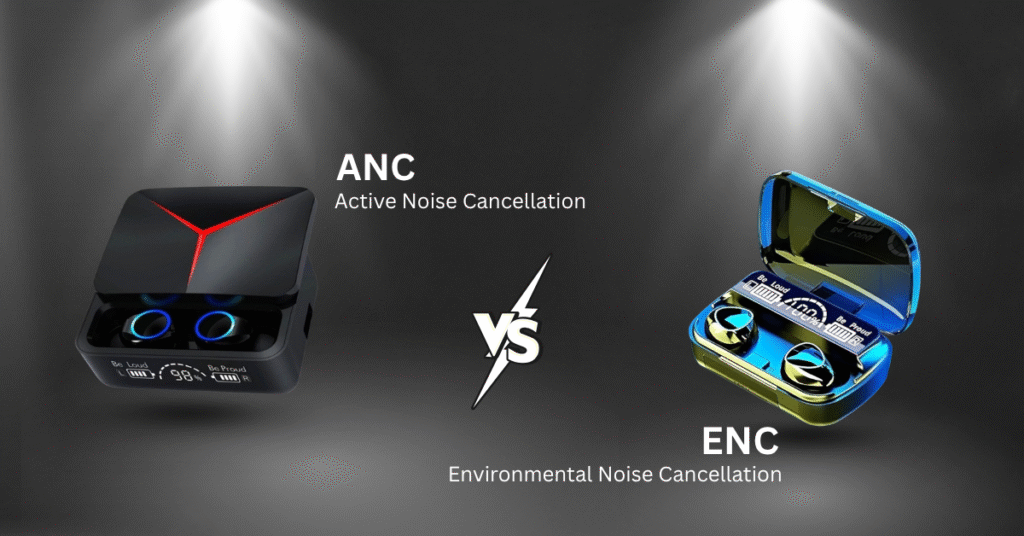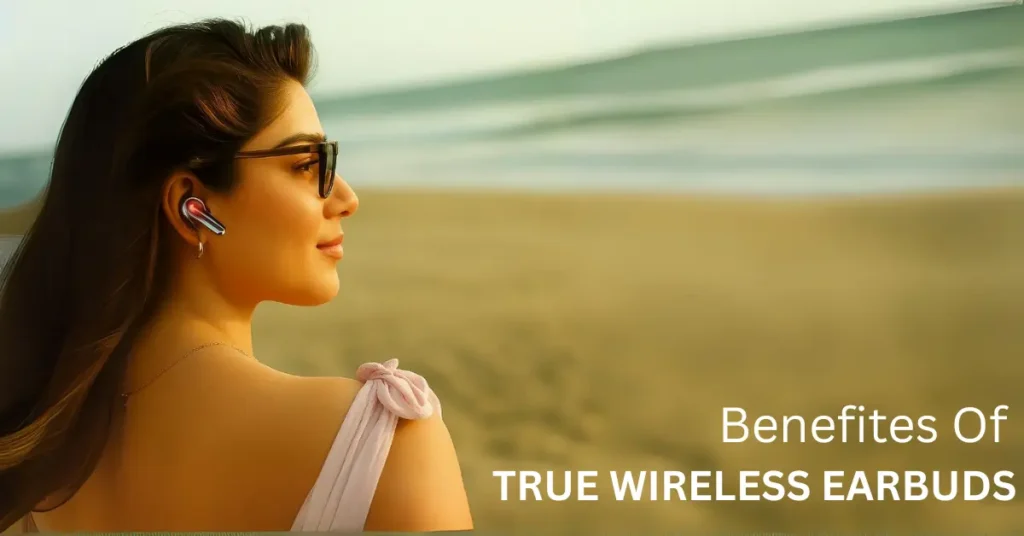
If you’ve ever shopped for headphones or wireless earbuds, you’ve probably seen the buzzwords ANC and ENC. Both relate to noise cancellation, but they work in different ways. This guide explains ENC vs ANC, how each works, and which is best for your needs. By the end, you’ll know when to use each feature to get the clearest calls or the most immersive listening experience.
Many people struggle with noisy environments, whether it’s the hum of an airplane engine or a chattering cafe, and both ENC and ANC exist to tackle that noise in their own ways. Understanding the difference will help you pick the right earbuds or headset for your situation.
What is Active Noise Cancellation (ANC)?
The ANC full form is Active Noise Cancellation, which is a technology that actively blocks out unwanted ambient noise. In simple terms, microphones in the headphones or earbuds listen to the sounds around you (like engine hum or city noise) and the device generates a matching sound wave that is the same opposite (anti-phase) of the noise. When these opposing sound waves meet, they cancel each other out, effectively silencing the background hum in real time.
ANC works best on constant, low-frequency noises. Think of an airplane’s rumble, a train’s steady clatter, or the hum of an air conditioner. In these cases, ANC creates a quiet bubble around your ears, so you can enjoy music or podcasts without cranking up the volume.
When to use ANC: Flying or commuting, working in a busy office or café, or any situation where you want to immerse yourself in audio. ANC is often found in high-end earbuds and over-ear headphones designed for music lovers and travelers.
What is Environmental Noise Cancellation (ENC)?
ENC full form is Environmental Noise Cancellation, which is a technology designed for clearer calls and voice chats, rather than music listening. ENC uses the microphones in your earbuds or headset to pick up both your voice and the surrounding noise, and then digitally filters out the unwanted background sound. In other terms, ENC algorithms separate your speech and suppress everything else, so the person on the other end listens you loud and clear.
ENC is especially useful for cutting out high-frequency noises like chatter, keyboard clicks, or office buzz during a call. Imagine you’re on a work call from a busy cafe: ENC will notch down the coffee machine and crowd noise while letting your voice come through clearly to the listener. (Just remember, ENC doesn’t block the noise for your ears; it only cleans up the signal sent through your microphone. You may still hear background sounds yourself.)
When to use ENC: If you frequently make phone or video calls from noisy places (cafes, streets, open offices, etc.), ENC will make your voice more intelligible to others. Many earbuds and headsets aimed at professionals or gamers include ENC specifically for this reason.
ENC vs ANC: Which is Better
To compare ENC vs ANC side by side:
- Purpose: ANC is for your listening experience (music, podcasts, movies). It cancels ambient sounds so you hear more of your audio content. ENC is for call clarity. It cleans up background noise on your microphone so others hear your voice clearly like ultrapods pro earbuds.
- How it works: ANC headphones use external mics to measure ambient noise and then play an inverse sound wave to cancel it. ENC uses the mic’s signal processing to separate your speech from background sound, suppressing the noise in the transmitted audio.
- Typical use case: ANC is great for travel, commuting, or focused listening – anywhere you want to reduce constant, steady noises (airplanes, trains, AC hum). ENC shines when you’re talking in noisy settings, like on calls in a crowded cafe or open office.
- Noise type: ANC excels at blocking out continuous low-frequency hum (engine rumble, HVAC). ENC is most effective at removing intermittent high-frequency noise (chatter, keyboard clicks, wind gusts) from your mic input.
- Device & Power: ANC usually requires more processing power and battery (so ANC earbuds sometimes have shorter battery life). ENC tends to be less power-hungry since it only processes audio during calls.
- Audio impact: Because ANC injects anti-noise, it can sometimes slightly affect audio quality (especially at very low volumes). ENC doesn’t change how your headphones play sound; it only cleans the outgoing voice signal.
Which is Better: ANC or ENC?
The answer is: it depends on your needs. Each technology excels in different situations:
- Want to tune out background noise for music or movies? Choose ANC. It actively creates a quieter listening environment so you can enjoy audio without distraction.
- Need clear calls and video chats in a noisy setting? Choose ENC. It filters out ambient sounds from your microphone so others hear your voice clearly.
- Frequent travel (airplanes, subways)? ANC is usually better at blocking constant engine or crowd noise.
- Working in an open office or busy cafe? ENC will help co-workers or clients focus on your voice, not the background buzz.
- Versatility: Many modern earbuds and headsets offer both features. You might see an ANC+ENC switch or a hybrid mode. This lets you use ANC for media and still get ENC on calls.
In summary, neither is absolutely better on its own – it comes down to your situation. For pure immersion, ANC wins; for speech clarity, ENC does the trick.
Tips and Best Practices
- Tip: Check your fit. A snug earbud seal boosts passive noise isolation, making ANC more effective. If earbuds aren’t seated properly, even ANC won’t block all sound.
- Tip: Use the right mode. On calls, switch to an ENC mode (if available) so others hear you clearly. When listening to media, turn on ANC or noise-cancelling mode for quieter playback.
- Tip: Mind your battery. ANC can drain earbuds faster since it runs constantly. Turn off noise cancellation when you don’t need it (or if the battery is low).
- Warning: At very low volumes, some ANC headphones may sound tinny or muffled. If music sounds odd, try raising the volume a bit or toggling ANC off.
Tip: During windy outdoor use, ANC can actually amplify wind noise. If you jog or bike outside, consider using a headset designed to handle wind or turn ANC off for clearer audio and use ENC if on a call.
Conclusion
ANC and ENC serve two different purposes in noise cancellation. ANC creates a quieter listening environment by actively cancelling ambient sound, making it ideal for music, travel, and focus. ENC, on the other hand, cleans up your voice on calls by filtering out background noise picked up by the microphone.
There is no single better technology overall, it depends on what you need. If your goal is immersive sound, ANC is the way to go. If you spend a lot of time on the phone or video calls in noisy places, ENC will make a bigger difference. Many modern earbuds include both, so you can switch modes as needed.
Next steps: Before purchasing, consider how you’ll use your earbuds or headset. Check if they support both ANC and ENC, and read reviews focused on real-world performance. By pursuing the given steps, you will definitely be able to get the best earbuds in India. With the right technology, your audio will be clearer, whether you’re listening or talking.


